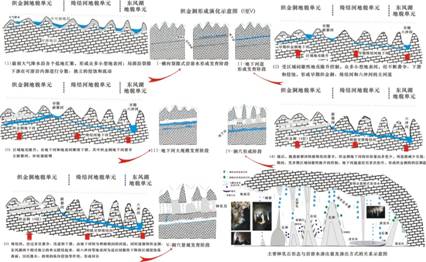Formation and evolution mode of Zhijindong Cave
In the late early Pleistocene, atmospheric precipitation infiltrated along longitudinal and tensile fissures, dispersing and independently corroding, eroding as well as laterally running along interformational fissure surface and stratification plane to form underground rivers with different development degrees and disperse directions. Among which, some underground rivers began to capture various surface water and other underground rivers, gradually forming the early main riverway of Zhijindong Cave.
In the early middle Pleistocene, After Zhijindong Cave underground river captured ancient Xinzhaihe River, its supplementary amount was increased dramatically, and its riverway became deeper, wider and longer; in the late middle Pleistocene, regional crust was bulged, therefore, the riverway of early stage was raised upwards, being formed the 3rd and 4th layer caves, meanwhile, entering the first stage of cave landscape development, which was represented by the formation of many huge stalagmite clusters; at this time, ancient Xinzhaihe River was captured by Qijiehe River, only supplementing to Zhijindong Cave during flood period, so it became underground riverway for flood discharging; about 100,000 years ago, the crust was bulged again, the riverway was raised upwards and formed the 2nd layer cave and entered the second stage of cave landscape development, which was represented by the formation of many long and slim stalagmite clusters and column clusters; from then on, Zhijindong Cave riverway has continued to submerge, forming substratum cave till now, however, it can only be supplemented indirectly by atmospheric precipitation, and the water volume decreases obviously.
Schematic diagram for formation and evolution of Zhijindong Cave
In conclusion, the formation and evolution of Zhijindong Cave began in Pleistocene, went through different subsurface karst circulation and development stages: lateral fissure karst water→underground riverway→capturing surface river (ancient Xinzhaihe River)→underground river in large scale→being raised upwards and formed fossil cave→cave landscape development. After being raised upwards for several times, the original underground riverway gradually formed a 4-layer labyrinth fossil cave system, Zhijindong Cave system; there are complete types of secondary chemical sediments, which are elegant, unique, and huge.

















